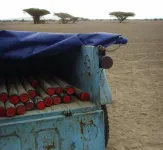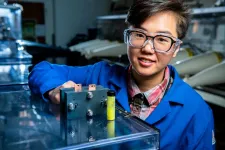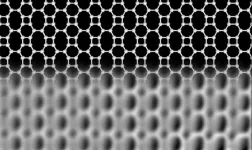(Press-News.org) At the start of the COVID-19 outbreak, a University of Illinois Chicago researcher conducted a survey asking respondents if they experienced health care delays because of the pandemic. In addition to learning about the types of delays, the study also presented a unique opportunity to capture a historic moment at the pandemic's beginning.
Elizabeth Papautsky, UIC assistant professor of biomedical and health information sciences, is first author on "Characterizing Healthcare Delays and Interruptions in the U.S. During the COVID-19 Pandemic Using Data from an Internet-Based Cross-Sectional Survey," published in the Journal of Medical Internet Research.
The study was conducted through an internet survey from April 5-May 5, 2020, and over 2,500 people responded. The results showed 48% of respondents experienced delayed health care, with the three most common delays being dental (38%), preventative (29%) and diagnostic (16%).
Fear of COVID-19 infection, health care provider discouragement, and the feeling that their health care concerns weren't as important as others were the top reasons people listed for delaying care, according to the study.
The study's results are not surprising, but worrisome as implications may include long-term health care decline, Papautsky said. For example, due to COVID-19's impact on preventive and diagnostic care, an uptick in cancer diagnoses and at higher stages is expected, she added.
Despite a convenience sample, which is often frowned upon in research, Papautsky said, important lessons can be learned.
"We captured a fleeting moment in time," she said. "This is an opportunity to learn how to do research in very dynamic situations. What lessons can we learn for when there are other situations where you need to get a survey out quickly and how can we do that better."
One surprising thing about the study was the number of respondents: 2,570 people, invited via social media, completed the 40-minute survey.
"People really cared about it. That shows the power of social media and the power of asking questions that people are concerned about," Papautsky said.
While the conditions for this study cannot be replicated, the methodological lessons learned can serve as a sort of "pilot study" for future crises, creating more diverse and inclusive research that drives health equity forward, the study reports.
"There is an urgent need for sharing lessons learned, disseminating effective strategies for reaching more diverse populations, and encouraging the research community to employ and improve upon these strategies in future research," Papautsky said.
INFORMATION:
The study's co-authors are Dylan Rice of Massachusetts General Hospital, Boston; Hana Ghoneima, AnnaLaura McKowen, Nicholas Anderson and Cindy Veldhui all of Columbia University, New York; and Angie Wootton of the University of California, Berkeley.
During the first phase of the COVID-19 epidemic, New York City experienced high prevalence compared to other U.S. cities, yet little is known about the circulation of SARS-CoV-2 within and among its boroughs. A study published in PLOS Pathogens by Simon Dellicour at Université Libre de Bruxelles, Belgium, Ralf Duerr and Adriana Heguy at New York University, USA, and colleagues describe the dispersal dynamics of COVID-19 viral lineages at the state and city levels, illustrating the relatively important role of the borough of Queens as a SARS-CoV-2 transmission hub.
To better understand how the virus dispersed throughout New York ...
Ancient pollen samples and a new statistical approach may shed light on the global rate of change of vegetation and eventually on how much climate change and humans have played a part in altering landscapes, according to an international team of researchers.
"We know that climate and people interact with natural ecosystems and change them," said Sarah Ivory, assistant professor of geosciences and associate in the Earth and Environmental Systems Institute, Penn State. "Typically, we go to some particular location and study this by teasing apart these influences. In particular, we know that the impact people have goes back much earlier than what is typically ...
A compound used widely in candles offers promise for a much more modern energy challenge--storing massive amounts of energy to be fed into the electric grid as the need arises.
Scientists at the U.S. Department of Energy's Pacific Northwest National Laboratory have shown that low-cost organic compounds hold promise for storing grid energy. Common fluorenone, a bright yellow powder, was at first a reluctant participant, but with enough chemical persuasion has proven to be a potent partner for energy storage in flow battery systems, large systems that store energy for the grid.
Development of such storage is critical. When the grid goes offline due to severe weather, for instance, the large batteries under ...
Wherever ecologists look, from tropical forests to tundra, ecosystems are being transformed by human land use and climate change. A hallmark of human impacts is that the rates of change in ecosystems are accelerating worldwide.
Surprisingly, a new study, published today in Science, found that these rates of ecological change began to speed up many thousands of years ago. "What we see today is just the tip of the iceberg" noted co-lead author Ondrej Mottl from the University of Bergen (UiB). "The accelerations we see during the industrial revolution and modern periods have a deep-rooted history stretching back in time."
Using a global network of over 1,000 fossil pollen records, the team found - and expected to find - a first peak ...
Carbon exists in various forms. In addition to diamond and graphite, there are recently discovered forms with astonishing properties. For example graphene, with a thickness of just one atomic layer, is the thinnest known material, and its unusual properties make it an extremely exciting candidate for applications like future electronics and high-tech engineering. In graphene, each carbon atom is linked to three neighbours, forming hexagons arranged in a honeycomb network. Theoretical studies have shown that carbon atoms can also arrange in other flat network patterns, while still binding to three neighbours, but none of these predicted networks had been realized until now.
Researchers at the University of Marburg ...
Analyzing data obtained with the Atacama Large Millimeter/submillimeter Array (ALMA), researchers found a galaxy with a spiral morphology by only 1.4 billion years after the Big Bang. This is the most ancient galaxy of its kind ever observed. The discovery of a galaxy with a spiral structure at such an early stage is an important clue to solving the classic questions of astronomy: "How and when did spiral galaxies form?"
"I was excited because I had never seen such clear evidence of a rotating disk, spiral structure, and centralized mass structure in a distant galaxy in any previous ...
A new study published in the journal Science, highlights the opportunity to complement current climate mitigation scenarios with scenarios that capture the interdependence among investors' perception of future climate risk, the credibility of climate policies, and the allocation of investments across low- and high-carbon assets in the economy.
Climate mitigation scenarios are key to understanding the transition to a low-carbon economy and inform climate policies. These scenarios are also important for financial investors to assess the risk of missing out on the transition or making the transition happen too late and in a disorderly fashion. In this respect, the scenarios developed by the platform of financial authorities ...
Deaths caused by indirect effects of the pandemic emphasize the need for policy changes that address widening health and racial inequities.
More than 15 months into the pandemic, the U.S. death toll from COVID-19 is nearing 600,000. But COVID-19 deaths may be underestimated by 20%, according to a new, first-of-its-kind study from Boston University School of Public Health (BUSPH), the University of Pennsylvania, and the Robert Wood Johnson Foundation.
Published in the journal PLOS Medicine, the study uses data from the National Center for Health Statistics (NCHS) and the Centers for Disease Control and Prevention ...
ITHACA, N.Y. - Cornell University engineers and plant scientists have teamed up to develop a low-cost system that allows grape growers to predict their yields much earlier in the season and more accurately than costly traditional methods.
The new method allows a grower to use a smartphone to record video of grape vines while driving a tractor or walking through the vineyard at night. Growers may then upload their video to a server to process the data. The system relies on computer-vision to improve the reliability of yield estimates.
Traditional methods for estimating grape ...
INFORMS Journal Information Systems Research Study Key Takeaways:
In real-time feedback the relationship source (peer, subordinate or supervisor) plays a role: the feedback tends to be more critical when it is from supervisors.
Favoritism and retribution are impacted in real-time feedback: Supervisors adopt tit-for-tat strategies, but peers do not.
Men rate women higher than men, and women rate men and women similar to how men rate men.
Positive real-time feedback has a stronger effect on future ratings than negative feedback.
CATONSVILLE, MD, May 20, 2021 - To deliver real-time feedback to support employee development and rapid innovation, many companies are replacing formal, review-based performance management with systems that enable frequent and continuous employee evaluation. ...





